Remember when Lord Horror-show Nelson defeated Napolean Cumberbatch at the Battle of Trafalgar Square? No? Good, because it never happened. Once again, here is an excerpt from Cunk on Britain, Episode 2, in which the clueless Philomena Cunk thoroughly mangles the history of Britain. Here is about 2 minutes of silliness. If you would like to watch the entire episode, click here.
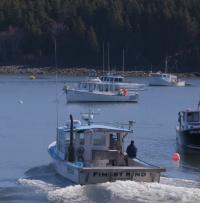 The lobstermen of Maine are known for their independence. They don’t often ask for help. Like many other states, Maine has been struck hard by the opioid crisis. In many coastal communities, opioid addiction is taking a serious toll, particularly on lobstermen. How serious the problem is hard to say. Of the 376 people who died of drug overdoses in Maine last year, one cannot identify how many were fishermen as the state doesn’t keep records by profession. Anecdotally, however, the number appears to be disproportionately high. Some estimate that up to 50% of the stern men working in the $1.6 billion dollar a year industry have or have had problems with addiction.
The lobstermen of Maine are known for their independence. They don’t often ask for help. Like many other states, Maine has been struck hard by the opioid crisis. In many coastal communities, opioid addiction is taking a serious toll, particularly on lobstermen. How serious the problem is hard to say. Of the 376 people who died of drug overdoses in Maine last year, one cannot identify how many were fishermen as the state doesn’t keep records by profession. Anecdotally, however, the number appears to be disproportionately high. Some estimate that up to 50% of the stern men working in the $1.6 billion dollar a year industry have or have had problems with addiction.
CBS News reports on one survivor: Josh Kane has spent more than 15 years fishing off the coast of Maine. For 10 of those years, he struggled with an opioid addiction as his fellow lobstermen looked the other way.
 On Tuesday, the 149 passengers on Southwest Airline’s Flight 1380 were shocked when about 20 minutes after takeoff from New York, the plane’s left engine exploded, blowing a hole in the fuselage. The rapid depressurization sucked one woman passenger partially out of the plane. The explosion also damaged the left wing and the flaps.
On Tuesday, the 149 passengers on Southwest Airline’s Flight 1380 were shocked when about 20 minutes after takeoff from New York, the plane’s left engine exploded, blowing a hole in the fuselage. The rapid depressurization sucked one woman passenger partially out of the plane. The explosion also damaged the left wing and the flaps.
The plane, a 737-700, had lost one of its two engines. Not only was the power reduced by half but the thrust, which had been balanced between the two engines, was now coming from only the right side of the plane. The plane immediately went into an uncontrolled left roll of 40 degrees. Fortunately for all aboard, the pilot in command of the plane, brought the plane under control and made an emergency landing at the Philadelphia airport. While, tragically, the woman closest to the explosion died and six others were injured, in the hands of a less skilled pilot, all 149 aboard the plane would have likely died.
Captain Shults is among the only 6.2 percent of commercial pilots in the United States who are women. She is also one of the first females to be trained as a fighter pilot by the US Navy. She was the first woman to fly a US Navy F/A-18 Hornet.
 Researchers have located huge deposits of rare-earth metals in seabed mud off the Japanese island Minamitorishima, located 1,150 miles southeast of Tokyo. The discovery could have a major impact on both the Japanese and the world economy. Rare-earth metals are essential to modern technologies and are used in smartphones, hybrid vehicles, rechargeable batteries, wind turbines, light emitting diodes, compact fluorescent lamps, screen display panels, and many medical and military technologies.
Researchers have located huge deposits of rare-earth metals in seabed mud off the Japanese island Minamitorishima, located 1,150 miles southeast of Tokyo. The discovery could have a major impact on both the Japanese and the world economy. Rare-earth metals are essential to modern technologies and are used in smartphones, hybrid vehicles, rechargeable batteries, wind turbines, light emitting diodes, compact fluorescent lamps, screen display panels, and many medical and military technologies.
In recent years, China has had a near monopoly on the production of rare-earth metals, extracting 85 to 95 percent of the world’s rare-earth metal supply from large clay deposits in the country’s south. Despite their name, rare earth metals are actually not particularly rare although they are difficult to find in deposits from which they can be economically extracted.
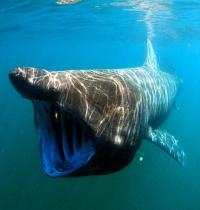 Aerial surveys attempting to identify endangered right whales have spotted swarms of basking sharks, in groups from 30 to up to 1,400, swimming in the waters from Long Island to Nova Scotia. Researchers who study the normally solitary sharks are not quite sure why. Nevertheless, reviews of the data suggest that such gathering are not that unusual. NOAA issued a press release on the sightings which said in part:
Aerial surveys attempting to identify endangered right whales have spotted swarms of basking sharks, in groups from 30 to up to 1,400, swimming in the waters from Long Island to Nova Scotia. Researchers who study the normally solitary sharks are not quite sure why. Nevertheless, reviews of the data suggest that such gathering are not that unusual. NOAA issued a press release on the sightings which said in part:
The reason why the animals congregate has not been clearly determined, although it is thought to be related to feeding, socializing, and/or courtship given behaviors in other shark species.
 The Flettner fleet is growing slowly but steadily. The LNG powered cruise ferry Viking Grace has become the latest commercial ship and the first passenger vessel to install a modern Flettner rotor sail. The 80-foot-tall rotor is expected to save fuel and to reduce carbon emissions by around 900 tonnes annually on the ship which runs between Turku, Finland and Stockholm, Sweden. The 57,565 GRT ferry, with a passenger capacity of 2,800, was also the first large passenger ferry to be powered by liquified natural gas (LNG) when it was delivered in 2013. The modern Flettner rotor designed, fabricated, and installed by Norsepower, is expected to save around 300 tonnes of LNG per year. Viking Line is currently building a new ship which will feature two Flettner rotors.
The Flettner fleet is growing slowly but steadily. The LNG powered cruise ferry Viking Grace has become the latest commercial ship and the first passenger vessel to install a modern Flettner rotor sail. The 80-foot-tall rotor is expected to save fuel and to reduce carbon emissions by around 900 tonnes annually on the ship which runs between Turku, Finland and Stockholm, Sweden. The 57,565 GRT ferry, with a passenger capacity of 2,800, was also the first large passenger ferry to be powered by liquified natural gas (LNG) when it was delivered in 2013. The modern Flettner rotor designed, fabricated, and installed by Norsepower, is expected to save around 300 tonnes of LNG per year. Viking Line is currently building a new ship which will feature two Flettner rotors.
One hundred and six years ago today, the White Star liner Titanic sank after striking an iceberg. Over 1,500 lives were lost. Here is a repost from 2012 of Joseph Conrad’s commentary on the sinking.
 In June of 1912, Joseph Conrad wrote “Some Reflections on the Loss of the Titanic” for the English Review. While best known as a novelist, his comments reflect his years as a ship’s officer in both sail and steam. He finds little to like in the events of that night in April, one hundred years ago today, or the events which followed. A few of Conrad’s thoughts on the media, icebergs, the design of unsinkable ships, biscuit tins and the romanticizing of needless death.
In June of 1912, Joseph Conrad wrote “Some Reflections on the Loss of the Titanic” for the English Review. While best known as a novelist, his comments reflect his years as a ship’s officer in both sail and steam. He finds little to like in the events of that night in April, one hundred years ago today, or the events which followed. A few of Conrad’s thoughts on the media, icebergs, the design of unsinkable ships, biscuit tins and the romanticizing of needless death.
On the Media:
He was offended by what we would all the media circus following the sinking. “It is with a certain bitterness that one must admit to oneself that the late _S.S. Titanic_ had a “good press.” ….. the white spaces and the big lettering of the headlines have an incongruously festive air to my eyes, a disagreeable effect of a feverish exploitation of a sensational God-send.”
Continue reading
 Two short accounts of seals showing up in somewhat unexpected places.
Two short accounts of seals showing up in somewhat unexpected places.
Recently, a large seal was spotted in York, in the UK, basking in the sun on the Yorkshire Dales. Apparently, the wayward seal swam 50 miles through Britain’s river network from the North Sea in pursuit of fish. Experts suggest that the seal become lost and disorientated after chasing a salmon or sea trout upstream. Or perhaps the seal just wanted to visit York.
On the other side of the pond, in New York harbor, a baby seal have been seen flopping about on the Jersey City side of the harbor recently. While seals were once common, they more or less disappeared from the harbor in the 20th century due to pollution and habitat destruction. They have been slowly returning in the current century, much to the delight and in some cases alarm of local residents. In the video below, from Wild Jersey City, the baby seal is hauling out on the old pier slipway next to Liberty State Park headquarters in Jersey City. Several different seals have been seen enjoying this spot.
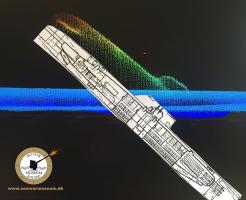 The Sea War Museum Jutland made an amazing discovery while scanning the sea floor off Denmark. They have identified the wreckage of one of the most technologically advanced German submarines of World War II, the U-3523. The submarine was found with its bow buried in the mud and its stern rising from the seafloor in 123 meters of water, ten nautical miles north of Skagen.
The Sea War Museum Jutland made an amazing discovery while scanning the sea floor off Denmark. They have identified the wreckage of one of the most technologically advanced German submarines of World War II, the U-3523. The submarine was found with its bow buried in the mud and its stern rising from the seafloor in 123 meters of water, ten nautical miles north of Skagen.
The U-3523 was a Type XXI submarine and was the most advanced submarine of its time, capable of operating underwater almost indefinitely, relying on large battery banks which could be recharged by snorkel. The hulls were streamlined and more hydrodynamically efficient than other submarines of the period. They could also use hydrogen peroxide as a fuel and were capable of operating at up to 17 knots submerged for short periods.
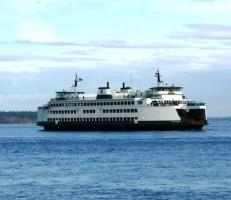 Talk about unintended consequences. The Washington State Ferry system and the US Coast Guard have a problem with forgotten bicycles. Over the last 18 months, 12 bicycles have been left aboard ferries, including three bike-share bikes. This turns out to be a rather big deal. Because a forgotten or abandoned bicycle might suggest that the owner could have gone overboard, it can trigger a search and rescue operation by Coast Guard and ferry personnel until the bicyclist can be confirmed safe.
Talk about unintended consequences. The Washington State Ferry system and the US Coast Guard have a problem with forgotten bicycles. Over the last 18 months, 12 bicycles have been left aboard ferries, including three bike-share bikes. This turns out to be a rather big deal. Because a forgotten or abandoned bicycle might suggest that the owner could have gone overboard, it can trigger a search and rescue operation by Coast Guard and ferry personnel until the bicyclist can be confirmed safe.
The Coast Guard issued a press release on Monday noting that a ride-share bike recently left aboard a vessel led to $17,000 in helicopter and crew costs searching for a missing person along the ferry route when, in fact, no one had fallen overboard.
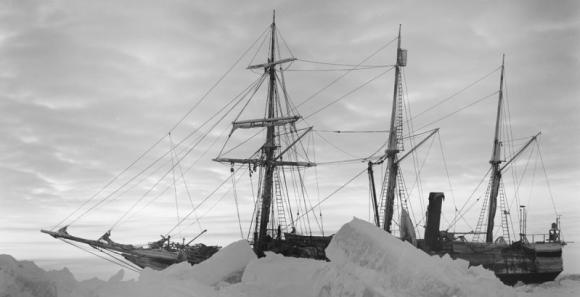 Next January and February, an expedition to Antarctica will search for Ernest Shackleton‘s doomed ship, Endurance, crushed by the ice in 1915. Finding the wreck of the ship is not the primary objective of the venture, however, which is to study the Larsen C ice shelf, where last summer one of the largest icebergs in recorded history calved from the ice shelf. The iceberg was almost the size of the state of Delaware and contained roughly a trillion tons of water.
Next January and February, an expedition to Antarctica will search for Ernest Shackleton‘s doomed ship, Endurance, crushed by the ice in 1915. Finding the wreck of the ship is not the primary objective of the venture, however, which is to study the Larsen C ice shelf, where last summer one of the largest icebergs in recorded history calved from the ice shelf. The iceberg was almost the size of the state of Delaware and contained roughly a trillion tons of water.
The Endurance is thought to have sunk in water 3,000 meters deep, beneath the Larsen C Ice Shelf in the Weddell Sea, relatively close to the location where the ice shelf research is scheduled to take place. In addition to their other activities, the team hopes to succeed where three previous attempts to find the stricken Endurance have failed.
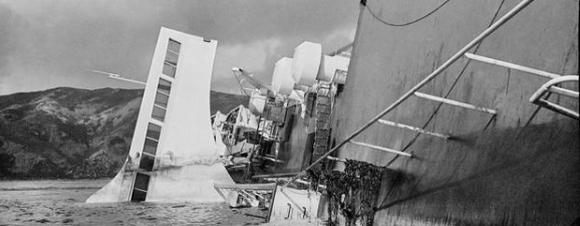
Photo: Tom Palaskas
Fifty years ago today, the interisland ferryWahine capsized and sank in shallow water after running aground near the mouth of Wellington harbor in New Zealand. The ship had been caught in a storm caused by Tropical Cyclone Giselle. Wahine was a twin-screw, turbo-electric, roll-on/roll-off passenger and vehicle ferry owned by the Union Steamship Company which ran between Wellington and Lyttelton. When the ferry sank, 53 of the 743 aboard died, most by drowning.
Recently, photos have emerged of the ship taken by a young art student, Tom Palaskas two days after the ship was wrecked. Click here to see the photos.
 Yesterday we posted about an out-of-control bulk carrier which, after losing its steering gear, destroyed a mansion on the banks of the Bosphorus. By my count, roughly half of the media reports described the ship as a tanker, because apparently, many in the non-maritime media think that all large merchant ships are tankers. Anyone who has spent time in shipping sooner or later expects the media to get at least the terminology wrong. With that in mind, we offer the video below from BBC2, in which Philomena Cunk explains what life must have been like on Drake’s ship, the Golden Hind, when they first circumcised the world.
Yesterday we posted about an out-of-control bulk carrier which, after losing its steering gear, destroyed a mansion on the banks of the Bosphorus. By my count, roughly half of the media reports described the ship as a tanker, because apparently, many in the non-maritime media think that all large merchant ships are tankers. Anyone who has spent time in shipping sooner or later expects the media to get at least the terminology wrong. With that in mind, we offer the video below from BBC2, in which Philomena Cunk explains what life must have been like on Drake’s ship, the Golden Hind, when they first circumcised the world.
Yes, this is satire. Philomena Cunk is a character developed by English actress, comedian, and writer, Diane Morgan. The clip, after the break, is from her BBC mockumentary series “Cunk on Britain.”
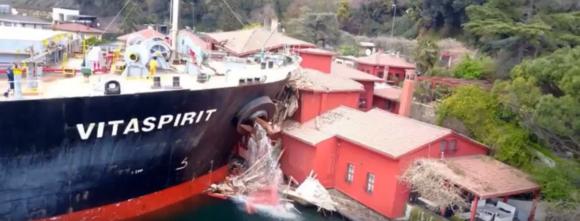 Saturday was a bad day on the Bosphorus. The Maltese-flagged 74,269 DWT bulk carrierVitaspirit suffered a steering gear failure while transiting Istanbul’s Bosphorus Strait. The ship was traveling south, approaching the Second Bosphorus Bridge, when it veered out of control. Fortunately, it missed the bridge, but the Hekimbasi Salih Efendi Mansion on the shore near the bridge was not as lucky. The 19th-century mansion was seriously damaged. The mansion’s roof and upper floors collapsed and videos showed the basement slumping into the water. The mansion was used to host weddings and concerts. No one was reported to be injured in the collision.
Saturday was a bad day on the Bosphorus. The Maltese-flagged 74,269 DWT bulk carrierVitaspirit suffered a steering gear failure while transiting Istanbul’s Bosphorus Strait. The ship was traveling south, approaching the Second Bosphorus Bridge, when it veered out of control. Fortunately, it missed the bridge, but the Hekimbasi Salih Efendi Mansion on the shore near the bridge was not as lucky. The 19th-century mansion was seriously damaged. The mansion’s roof and upper floors collapsed and videos showed the basement slumping into the water. The mansion was used to host weddings and concerts. No one was reported to be injured in the collision.
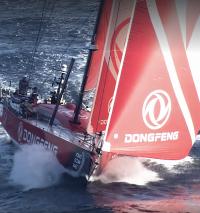 Yesterday, we posted about the upcoming Golden Globe 2018 Race in which traditional sailboats will race around the globe using only the technology available in the original race in 1968. The idea has a certain appeal but also definite limitations. There is something to be said for technology that lets arm-chair sailors catch a glimpse of the power and majesty of racing yachts screaming along in mid-ocean.
Yesterday, we posted about the upcoming Golden Globe 2018 Race in which traditional sailboats will race around the globe using only the technology available in the original race in 1968. The idea has a certain appeal but also definite limitations. There is something to be said for technology that lets arm-chair sailors catch a glimpse of the power and majesty of racing yachts screaming along in mid-ocean.
One of the most thrilling technologies, at least to my eyes, are the myriad of video feeds being recorded on the boats competing in the Velux and Volvo round the world races, among others. And of the range of cameras, some of the most exciting footage has come from drones launched and controlled from the decks of the racers.
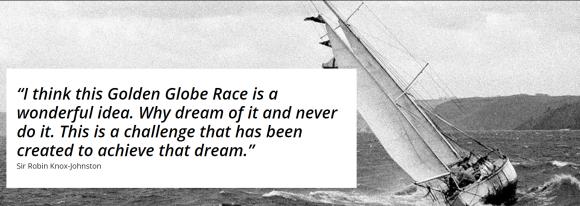 Fifty years ago this year, nine sailors set off in the Sunday Times Golden Globe Race. Only one, Robin Knox-Johnston sailing his 32-foot Bermudan ketch Suhaili, finished the race, becoming the first person ever to sail single-handed non-stop around the globe. This June, the race is being recreated in the Golden Globe 2018.
Fifty years ago this year, nine sailors set off in the Sunday Times Golden Globe Race. Only one, Robin Knox-Johnston sailing his 32-foot Bermudan ketch Suhaili, finished the race, becoming the first person ever to sail single-handed non-stop around the globe. This June, the race is being recreated in the Golden Globe 2018.
Unlike other single-handed round-the-world races, such as the Vendee Globe, which is sailed in modern Open 60 sailboats, including many featuring foiled hulls, the boats and the technologies used in the upcoming Golden Globe 2018 will harken back to 1968. From the GGR website:
As a RETRO Race, for the Golden Globe, generally speaking only equipment that was available to Robin Knox Johnston on Suhaili in 1968 may be used. That means NO GPS, Chart plotters, electronic wind instruments, electric autopilots, electronic log, iPhone, satellite phones, digital cameras, computers, cd players, pocket calculators electronic clocks and watches, water makers, carbon fibre, Kevlar, spectra etc… so it is back to film cameras, cassette tapes, sextants, wind up clocks, trailing logs and Dacron sails, wind vanes and typewriters.
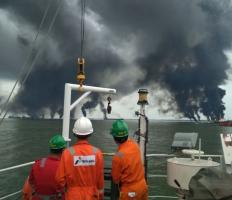
Photo: Pertamina
Six days ago, oil began spilling into Borneo’s Balikpapan Bay. The oil would spread to cover an area of nearly 13,000 hectares and pollute 60 km of coastal ecosystems, including mangrove wetlands and marine mammal habitats. At least one protected dugong was killed. The spill would also create an overpowering stench sweeping across Balikpapan, a city of 700,000 people. On March 31, the oil caught fire near the Panama-flagged bulk carrier, MV Ever Judger. At least four fisherman died and a fifth remains missing. One of the crew members on the bulker also suffered burns.
Where did the oil come from? For the first four or five days, there was only denial and finger-pointing.
 A new exhibit has recently opened at the Postal Museum in London — Voices from the Deep. The exhibit features undeliveredd letters retrieved from the wreck of the SS Gairsoppa, a British merchant ship which was sunk by a U-boat 300 miles southwest of Galway Bay in 1941. The SS Gairsoppa is best known for her cargo, which as well as pig iron and tea included 240 tonnes of silver. Between 2012-2014, Odyssey Marine Exploration, under contract with the UK government, recovered close to 99% of the insured silver from the wreck which is almost three miles deep.
A new exhibit has recently opened at the Postal Museum in London — Voices from the Deep. The exhibit features undeliveredd letters retrieved from the wreck of the SS Gairsoppa, a British merchant ship which was sunk by a U-boat 300 miles southwest of Galway Bay in 1941. The SS Gairsoppa is best known for her cargo, which as well as pig iron and tea included 240 tonnes of silver. Between 2012-2014, Odyssey Marine Exploration, under contract with the UK government, recovered close to 99% of the insured silver from the wreck which is almost three miles deep.
Remarkably, something far more rare than silver was also recovered from the wreckage. Twelve bundles of mail bundles of letters, over 700 letters and postcards, were miraculously preserved in an air pocket in the hold of the ship.
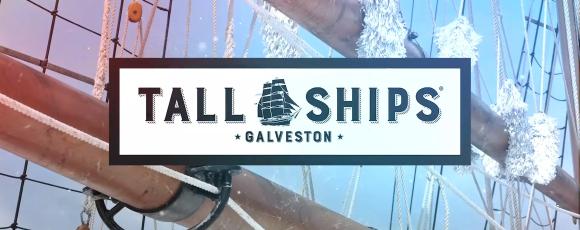 A fleet of tall ships is sailing to Galveston Island, Texas which will host Tall Ships Galveston from April 5 – 8th to kick off the Tall Ships Challenge Gulf Coast 2018 tall ship race. Included in the fleet will be:
A fleet of tall ships is sailing to Galveston Island, Texas which will host Tall Ships Galveston from April 5 – 8th to kick off the Tall Ships Challenge Gulf Coast 2018 tall ship race. Included in the fleet will be:
- Galveston’s Elissa, an 1877 square-rigged three-masted iron barque,
- Oliver Hazard Perry, a three-masted steel ship, commissioned in 2015, the largest civilian Sailing School Vessel in the United States and the first ocean-going full-rigged ship to be built in the U.S. in over 100 years,
- Oosterschelde, a three-masted topsail schooner built in 1918, from the Netherlands,
- Picton Castle, three-masted steel barque, built in 1928, registered in the Cook Islands, on its way toward its seventh circumnavigation,
- Lynx, replica Baltimore clipper privateer, delivered in 2001,
- When and If, a classic Alden schooner built in 1939 for General George S. Patton.
The Tall Ships Galveston festival will begin with a Parade of Sail down Seawall Boulevard on Thursday afternoon, April 5th. The festival is being produced by Galveston Historical Foundation, in partnership with Tall Ships America as a family-friendly event which will showcase Galveston’s rich maritime history through unique programming and the visiting tall ships. Tickets, ship information, and special event details are available here.
 As if things were not complicated enough, it appears that North Korea is building a second and more capable ballistic missile submarine. In addition to developing inter-continental range ballistic missiles launched from land, North Korea has for several years been working on the ability to launch missiles from submarines. The new ballistic submarine may be capable of launching long to intermediate range nuclear-armed missiles.
As if things were not complicated enough, it appears that North Korea is building a second and more capable ballistic missile submarine. In addition to developing inter-continental range ballistic missiles launched from land, North Korea has for several years been working on the ability to launch missiles from submarines. The new ballistic submarine may be capable of launching long to intermediate range nuclear-armed missiles.
There have been reports that the North Koreans have been developing Submarine Launched Ballistic Missiles (SLBM) since at least 2014. In 2016, the North Koreans launched what is believed to be a KN-11 intermediate range ballistic missile into the Sea of Japan from a Sinpo B class submarine, also called Gorae (“whale”).
